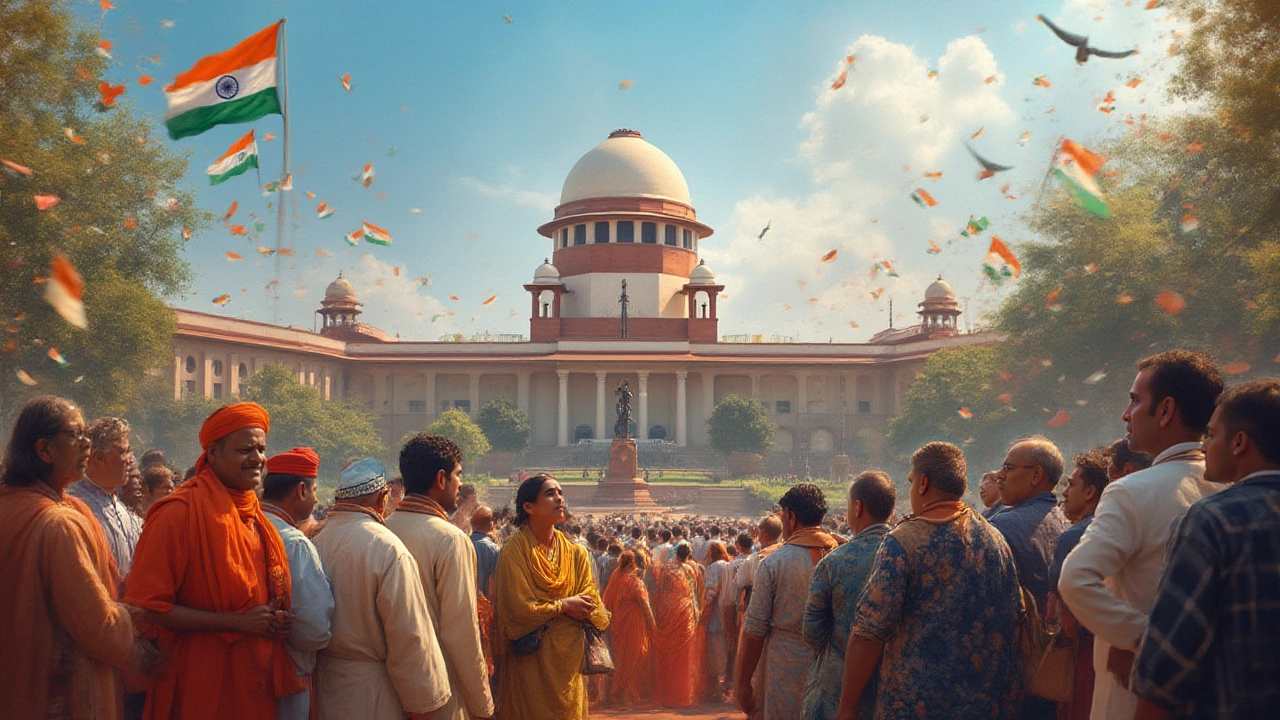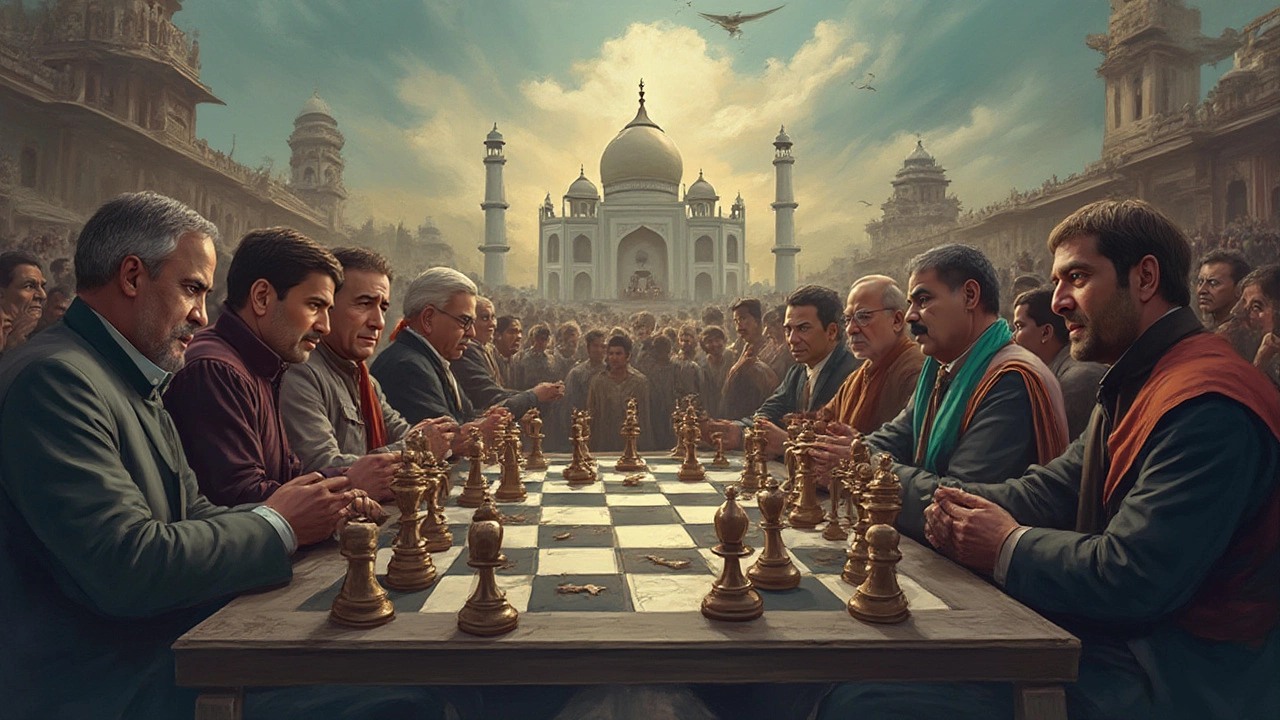Who Holds Real Power in India? Unraveling the Layers of Authority
 Jul, 12 2025
Jul, 12 2025
Power in India isn't as straightforward as one person sitting on a shiny throne and calling all the shots. Peel back the curtain, and you'll find a fascinating tangle of positions, institutions, and hidden forces. Ever wondered if the Prime Minister really runs everything, or if the President is secretly the ultimate boss? Maybe the Supreme Court, with its landmark judgments, has the last word? And what about the quiet power brokers behind closed doors? The real answer isn't black or white—it's woven into the fabric of India's history, constitution, and current affairs. If you think one person holds all the cards, get ready for a wild ride. Power in India is spread out, shifting, and much more complicated than it appears in textbooks or TV debates.
The Structure of Power: Constitution and Key Players
India's Constitution is the blueprint that draws the lines for everyone in authority. Right on paper, the 'highest power' looks like it belongs to the people—after all, India's first words are "We, the people of India..." But how does this actually play out? Technically, the President is the Head of State. Yet, ask around and most folks would say the Prime Minister runs the show. By law, most executive decisions need the nod from the PM and the Council of Ministers, who are answerable to Parliament. The President, while hugely respected, acts more like the ceremonial tip of the iceberg. For example, Article 74 of the Indian Constitution forces the President to act on the advice of the Council of Ministers—it sounds powerful, but in reality, the real steering is down a level.
Here's a simple breakdown of the main players and what each actually does:
| Position | Real Power | Role Explained |
|---|---|---|
| President | Mostly ceremonial | Signs off on laws, appoints PM, can send back laws once for reconsideration |
| Prime Minister | Decision Maker | Leads Cabinet, shapes policies, commands bureaucracy |
| Cabinet Ministers | Varies by portfolio | Run ministries, recommend laws, implement decisions |
| Supreme Court | Judicial Review | Interprets laws, checks abuse of power, can overrule government actions |
| Parliament | Creates Laws | Debates, makes and amends laws |
| Bureaucracy | Implements Policies | Runs day-to-day government, keeps the system moving |
The PM's office is the nerve center. Since independence, every major reform, crisis management, or big announcement has been drafted or at least blessed by the Prime Minister. Take Narendra Modi, for example: love him or hate him, his influence over everything from foreign policy to demonetization is hard to deny. Power in India flows to the one who builds coalitions, tames the bureaucracy, and manages public opinion well enough to keep Parliament on his side. The armed forces, too, come under civilian control, reporting to the President, but through the Cabinet and PM by custom and rules.
Hidden Hand: Judiciary, Money, and the Media’s Role
Don’t close the case just yet. The more you look, the murkier it gets. The Supreme Court in India can shut down entire policies with one judgment. Remember the 2018 Aadhaar verdict? Parliament passed a law making ID cards essential, but the Supreme Court reined it in, banning companies from demanding it for services. Time and time again, the judiciary has stepped in when the executive or legislature steps out of bounds. This 'judicial activism' is actually written into the checks and balances of the Constitution—judges interpret the law, and their word can be final.
And you can't ignore the role money plays. Behind every election, there’s a river of cash flowing through party funds and campaign trails. There are big donors—corporates, lobby groups, even overseas supporters—each with interests to protect. Scandals like the 2G spectrum case or the Panama Papers have shown how money influences not just elections, but policy decisions too.
Now, let’s talk media. You might know the famous saying that the media is the 'fourth pillar' of democracy. In India, this pillar sometimes towers taller than the others, shaping how people see events, spin narratives, set trends, and put pressure on politicians. A breaking news story, a viral video, or a trending hashtag can bring government action within hours, or tank a politician’s reputation. But here’s the twist—not all media is genuinely independent. With business houses owning major channels, and ads funding big newsrooms, even editors have bosses to please. So, while the media has enormous power, it too is part of the tangled web.

Power Beyond Delhi: States, Caste, Community, and Public Sentiment
Think it’s all happening in Delhi? Not a chance. India’s federal system hands huge power to state governments—chief ministers can make or break national policies. For instance, policing, health, and education are mostly state matters. Tamil Nadu’s refusal to implement the national language policy, Kerala’s fight over farm laws, or West Bengal’s standoffs with the central government are classic examples. Sometimes, local leaders rival or overshadow national figures.
Next layer: caste and community networks. You can’t ignore how powerful caste associations, religious leaders, and community groups are in setting the agenda. Remember the Jat agitation in Haryana or the Maratha protests in Maharashtra? They shut down highways and forced governments to negotiate. In election season, entire manifestos get rewritten to court powerful voter blocs.
Then, there’s public sentiment—millions of ordinary voters, activists, and protestors who can swing decisions. Think about the Anna Hazare anti-corruption movement or the farmers’ protests in 2020–21—both created enough buzz to wrangle unprecedented promises from those in power. Social media movements can trend and turn in a matter of days, uniting people across states and languages.
The Real Answer: A Shifting Network, Not a Single King
If you’re still searching for a single, absolute boss of India, you’re missing the bigger picture. The real highest power depends on the issue, the timing, and the context. Sometimes it’s the PM, especially in foreign policy or national defense. At other times, it’s the courts, state leaders, or even a mob of determined citizens capturing the nation’s mood. The system is almost designed to keep real, unchecked power out of any one person’s hands—think of it as a spinning top balanced by many forces.
Here are a few tips if you’re watching Indian power play out and want to understand what’s going on:
- Watch Parliament sessions for a real sense of how laws are actually made (they’re often spicier than reality TV).
- Read Supreme Court verdicts on major cases—they can change policies overnight.
- Follow state-level politics, especially in election years; big shifts often happen in the states first.
- Track economic and business news. When big corporates make moves, politicians often adjust their priorities too.
- Keep an eye on social trends—when a topic goes viral, power-holders usually pay attention fast.
The numbers also tell an interesting story. As of July 2025, India has over 960 million voters, 28 states, and more than 2,500 recognized political parties. The Lok Sabha has 543 members, the Rajya Sabha 245, and nearly 19,000 judges shoulder the load in courts across the country. You’ll find endless debates, but rarely a single unchallenged authority.
If you thought one person holds the magic button, think again. In India, power is an ever-shifting puzzle. Watch closely and you’ll see the tiniest move in one corner setting off ripples all the way across the system. That’s what makes the country both unpredictable and endlessly fascinating.